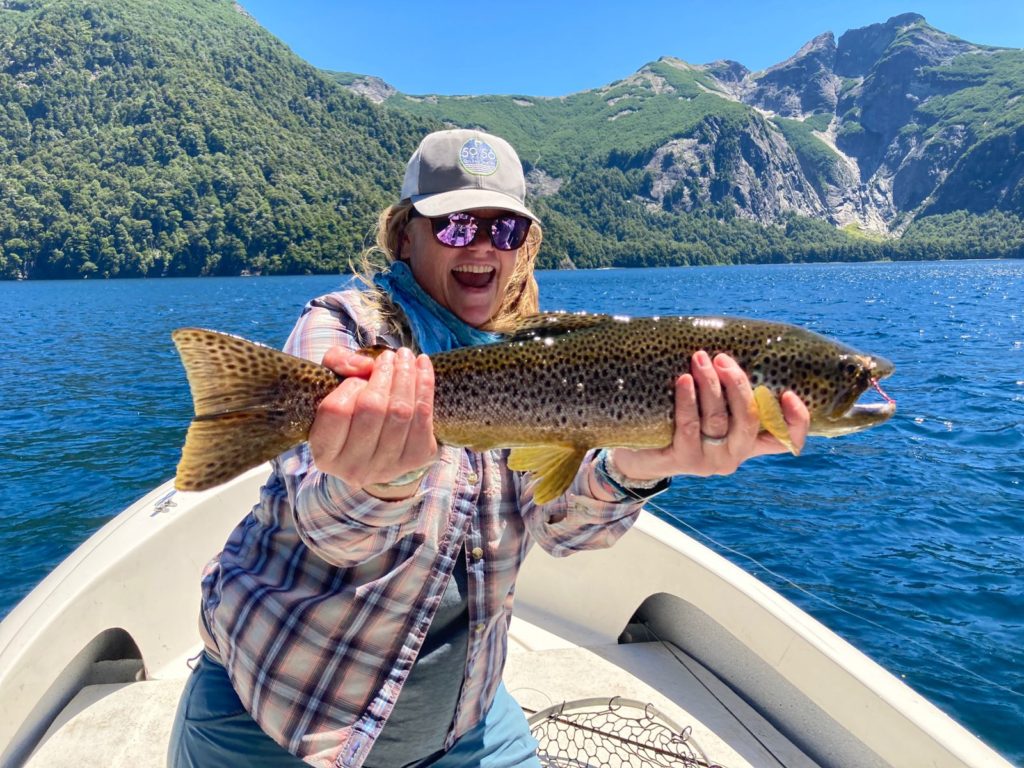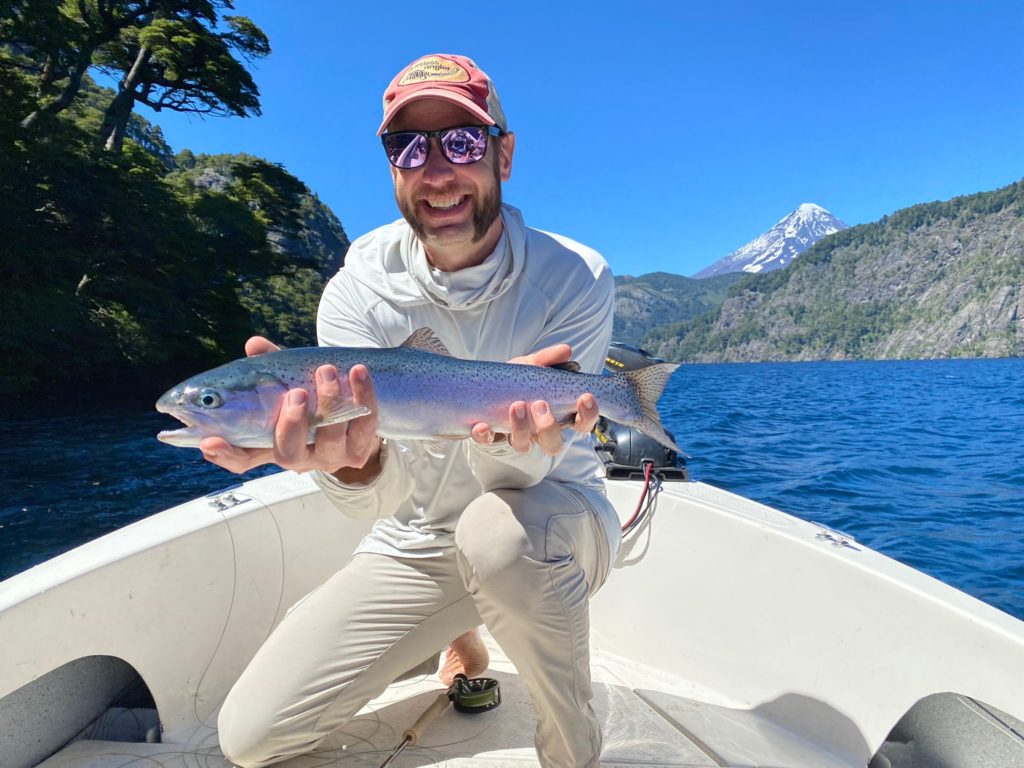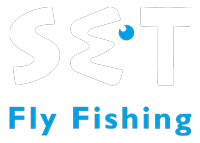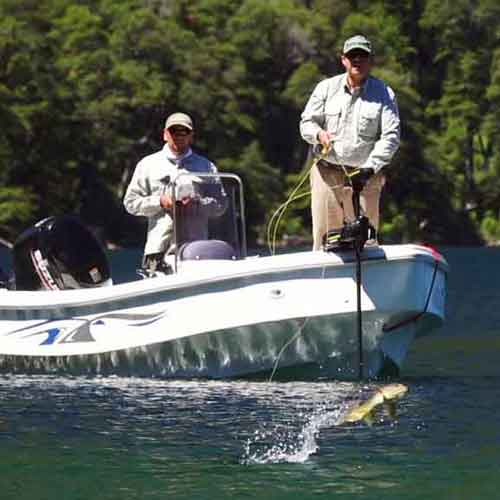Fishing the Dragonfly Hatch
in The Lake District
Northern Patagonia holds numerous natural lakes originally created by glaciers carving out the valleys of the Andes Mountains. These are typically large but narrow bodies of water with maximum depths often exceeding 1,200 feet. These lakes are the source of water for most of the rivers we fish and float, and provide our rivers with stable and reliable flows, as these lakes are not regulated by dams.
Known as the Lake District, the region features breathtaking alpine scenery. The slopes of the mountains are covered by a cold rain forest, and the lakes are crystal clear; in many places, we can see to the bottom in more than 20 feet of depth.

Located inside our National Parks, the lakes are home to robust populations of rainbow, brown and brook trout, and provide great opportunities to catch large fish. (The average size of the trout that inhabit the lakes is larger than the average size of the trout that live in the rivers). Many trees overhang the shorelines and much of the fishing activity occurs in the shallow waters, before the lakes drop off to deep depths. The trout are constantly cruising the shoreline to feed on terrestrials that fall from the trees and are blown into the water by the wind. This presents anglers with the special opportunity to fish with dry flies matching the terrestrials. The most effective way to fish the lakes is by prospecting deep drop-offs and casting along reed beds and rock points along the shores. Sight-fishing to cruising fish with dry flies is very exciting—you’ll never forget the sight of a large trout rising in crystal clear water to take your fly.

Since the insects normally don’t fly away, the trout have plenty of time to study what they will eat. For this reason, they typically feed in slow motion. A common mistake is to set the hook too early, before the trout has taken the fly all the way into its mouth. The one exception is when we see the dragonflies hatch. Since dragonflies are rich in protein and will fly away as quickly as possible, the trout race up from the depths to eat them at full speed, often jumping a couple feet into the air to catch the insects. The strikes are like no others you have ever experienced! The trout will leap completely out of the water and smash the fly on their way down, creating big splashes and boils.
During a certain time of year, adult dragonflies make up a substantial part of a trout’s diet. They are distributed along the shores of the lake, but are mostly concentrated in the shallow bays and around reeds. The nymphs are available year-round, but by the end of December, the nymphs will have hatched into winged adults that fly over the surface of the water. This is when the trout will focus on catching them.

Without wind, dragonflies are very good flyers; they will rarely touch the surface and if they do, it is for just a brief moment. When the wind picks up, it knocks the dragonflies into the water, especially when the dragonflies are feeding on smaller insects just above the surface. Dragonflies will also fall on the water during the mating process, when the female lays the fertilized eggs in the water. When this happens, the trout seize the opportunity to strike.
Skating flies on long leaders is the most effective way to trigger the fish to attack. According to our guests, the dragonfly hatch is always a highlight of the trip, because it is a unique experience to see trout take a fly so aggressively and make such acrobatic jumps. While the peak of the hatch is two weeks, the whole period extends for almost five weeks. Throughout this time, the trout will keep dragonfly adults at the top of their menu. Late spring and early summer are the best times of year to fish these lakes.
Other trout articles
Some of you may now; Rachel Finn has been an ambassador and great friend for SET for several years now. She has been hosting groups regularly to all our lodges for golden dorado and trout.Last year we had the opportunity…
November 1st is a day to celebrate. By Gonzalo Flego Beyond the anticipation of Christmas as a boy, the day that stirs my imagination now as a man is opening day of trout season here in northern Patagonia. I wait…
Limay Medio is Back I began guiding and exploring the nearly infinite number of rivers and streams in northern Patagonia over twenty-five years ago, and I’ve always enjoyed the challenges we faced as a team of guides to interpret the…
Hunting Trout at Casa de Campo Lodge Fly fishing clients often ask us: how do you hunt trout? I like to explain it as a game of strategy that more resembles a hunting expedition rather than typical fly fishing tactics.…
No plans this winter there is still time! Have you been holding off finalizing plans for international travel? We have been getting numerous calls related to the 2023 winter season ahead from friends who have been reluctant to schedule a…
A Special Season in Patagonia! Hi folks! Another trout season in Patagonia is around the corner, and we have news about the rare conditions to share with you.We have had an extraordinary winter, which means the rivers and lakes in…
Deep in the Canyon Trocoman House at Estancia Ranquilco By Gonzalo Flego I had been to Chochoi Mallin many times before, even before the new lodge was built. It was always a treat to guide in this place that was…
The defining feature of this area is the population of wild, healthy rainbow and brown trout throughout the mountain watersheds, as well as brook trout in some places. In particular, the rainbow trout are remarkably stout and strong when compared to other regions in northern Patagonia.
News From Spring Creek Lodge by Gustavo Hiebaum Season after season, we welcome back a large number of repeat guests that over the years have chosen us for their yearly visit to Argentina. Along with them, families and new friends…
These adventures are commonly reviewed as the highlight of the trip and more often we have requests from repeat anglers to do more adventure venues, which has been the motor for us to constantly seek for the next one to find.
Intimate Waters in Northern Patagonia Northern Patagonia and the Lakes District is one of the most fished and explored trout fishing regions in Argentina. But amazingly, there are so many river systems and wild fisheries in this part of the…
To prepare for the trip, we studied satellite images to determine the length of the float and possible rough waters sections that might make the adventure a risky one.
During this hatch, trout gorge themselves on the protein-rich worms, presenting anglers with the exciting opportunity to sight-fish to trout feeding very actively on the surface. The fishing can be so unbelievably good that many of our guests schedule their trips around the hatch.
During a certain time of year, adult dragonflies make up a substantial part of a trout’s diet. The strikes are like no others you have ever experienced!
Chochoy Mallin is truly the last frontier of fly fishing in Patagonia. The area is breathtakingly beautiful and features many picturesque streams to walk and wade.
Imagine how restless you would feel if for five months of the year, all fishing near you was closed due to government regulations.
(...)
...It is truly spectacular to witness rainbows and browns feed very aggressively, splash and break the surface to attack these minnows at strategic places of the river. The strength and power of these trout after feeding for a while on minnows is mind-blowing...
Landon Mayer´s "South to Patagonia" Last December I had the great fortune of finding myself in a run with multiple prime trout holding locations, and incredible amounts of large adult fish going absolutely berserk in a feeding frenzy. The biggest…
There is no way to predict every fishing situation that you may encounter but, after years of traveling in Argentina to here is the list of tackle that we recommend for San Martin area and surrounding streams.
Fly Fish Food´s visit to Patagonia Last summer Curtis and Cheech from Fly Fish Food spent a week with Andes Drifters (now SET Fly Fishing). Below, their experience in first person."Curtis and I arrived at the airport in San Martin…

